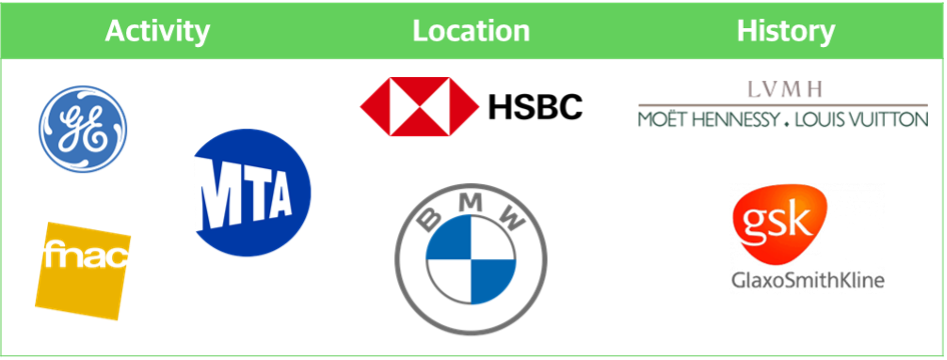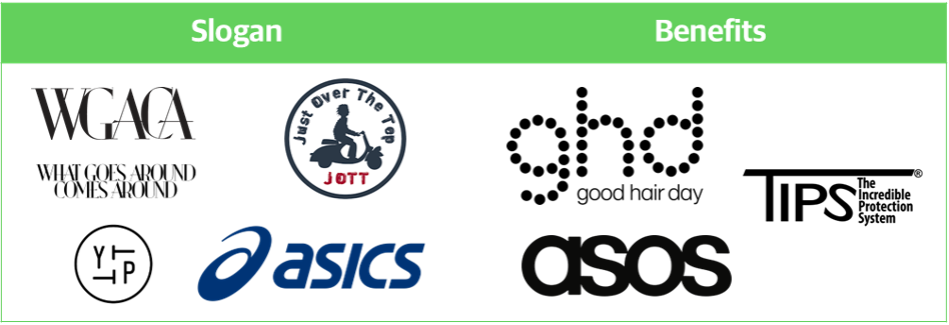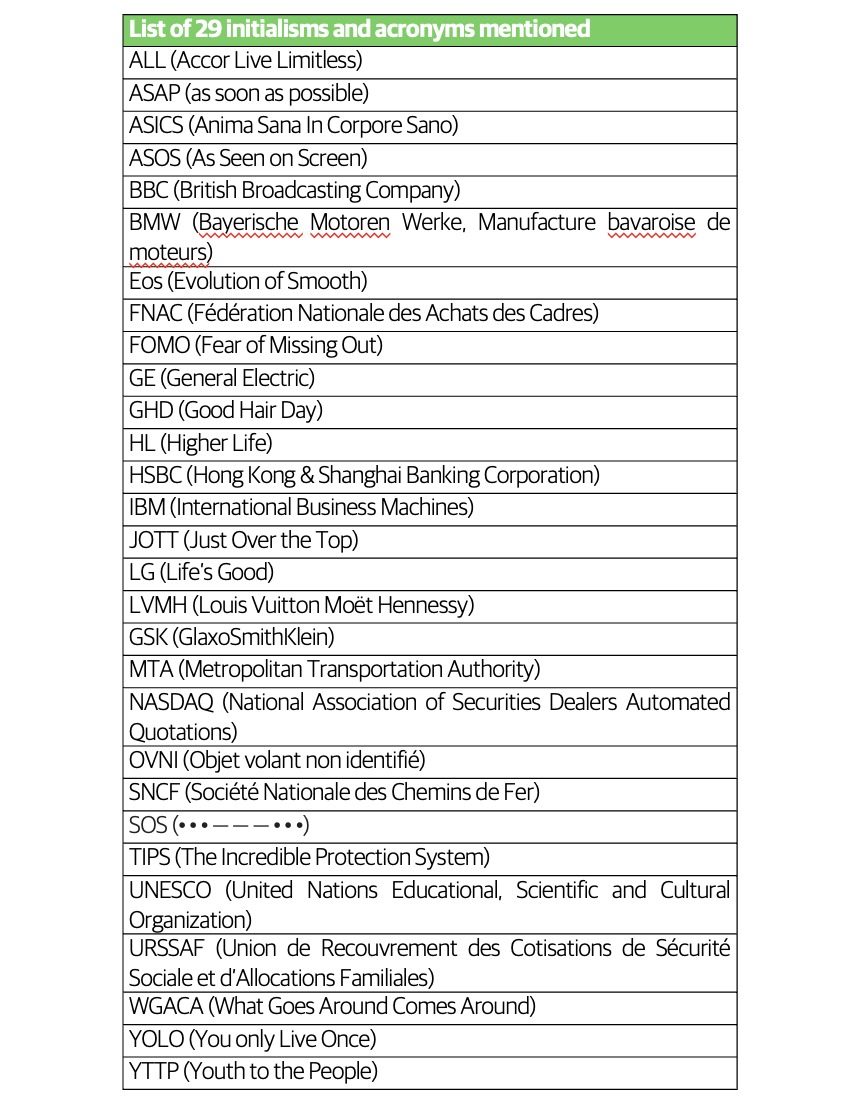

When rebranding in 2019, AccorHotels became Accor and created a new brand for its loyalty program: ALL, “Accor Live Limitless”. This acronym reflects the mission statement made by the group: to offer discovery and experiences, the chance to “live the extraordinary”. The distinctive ‘Live Limitless’ phrase, exclusive to Accor, communicates this ambition through a conversational name—a powerful brand acronym encapsulating a unique attitude.
Unlocking the power of brand acronyms, Accor’s rebranding in 2019 showcases the resurgence of this once-deemed outdated naming convention. ALL, short for ‘Accor Live Limitless,’ not only reflects a compelling mission but also enables the brand to connect with consumers on a personal level. Explore whether this is an isolated case or an emerging trend in the dynamic landscape of brand identities.
Before delving into the analysis of these name types, let’s clarify the terminology: formally, initialisms, such as BBC (British Broadcasting Corporation), are pronounced letter by letter. On the other hand, acronyms, like NASDAQ (National Association of Securities Dealers Automated Quotations), are pronounced like ordinary words. Explore the nuances of brand acronyms and initialisms in this exploration of name types.
Traditionally, brand acronyms and initialisms have carried an institutional weight. Institutions and companies abound with examples whose meanings may have faded over time: UNESCO (United Nations Educational, Scientific and Cultural Organization), URSSAF (Union de Recouvrement des Cotisations de Sécurité Sociale et d’Allocations Familiales) in France, IBM (International Business Machines), and more. Explore the historical significance and evolving landscape of brand acronyms in this exploration.
These initialisms and acronyms, often descriptive, tend to use professional lingo. They can be distributed into different categories:
1. Initialisms that describe the company and its activities, expressing broadly what the company does, its line of business, like GE (General Electric), the MTA (Metropolitan Transportation Authority), or more specifically in the field, like FNAC (Fédération Nationale des Achats des Cadres).
2. The “location” initialisms, that mention the origin/territory, such as HSBC (Hong Kong & Shanghai Banking Corporation) or BMW (Bayerische Motoren Werke).
3. The “historical” initialisms, often from surnames such as LVMH (Louis Vuitton Moët Hennessy) or GSK (GlaxoSmithKlein), which, unlike the others, are often “shortened” following mergers and acquisitions. They often create a link to the past, integrate different entities by listing them.

Across various categories, brand acronyms and initialisms often communicate a company’s identity in a rational and objective manner, maintaining a sense of formality. While informative, they can lack accessibility and consumer appeal. The condensed letter arrangements may render the name distant, evoking little emotion and connection with the audience. Explore the balance between clarity and consumer engagement in the realm of brand acronyms.
However, there are some exceptions that can be observed: when the acronyms are thought of as a word, a form of language, with particular attention to phonetics. It is the case with the UNESCO (United Nations Educational, Scientific and Cultural Organization), which, with a soft sound and the prefix “UN”, carries notions of attention, peace, harmony, and unity.
The evolution of initialisms: from institutional to human, serious to conversational
Discover the trend of contemporary brand acronyms like YTTP, GHD, WGACA, LG, Jott, and more. Despite their seemingly cold and mysterious exterior, these names share a common foundation—they are crafted from phrases. By infusing idioms, sayings, and expressions, these brands reinvent the genre, delivering genuine messages that spark conversation and create a powerful image. Explore the allure of modern brand acronyms and the art of conveying meaningful messages.
Among the messages conveyed, we can find two big families:
1. The “slogan” initialisms or acronyms, that express a point of view, a vision, or a commitment. They can come from idioms, everyday conversations, songs, movie titles, and sayings, such as WGACA, a vintage store, which means “What Goes Around Comes Around”, ASICS, “Anima Sana In Corpore Sano” (healthy mind, healthy body). It can also be a twist on existing sayings, or one created specifically, like JOTT, “Just Over the Top” and YTTP, “Youth to the People”.
2. Sayings or nouns that mix descriptors and benefits in conversational language. For example, GHD, a brand of hair styling tools, means “Good Hair Day”, signifying that its products can better everyday life, like TIPS, a brand of nail polishes, which means “The Incredible Protection System”, or ASOS, “As Seen on Screen”.

These names are often in English, which makes them more universal, and these two families use human, simple, accessible language.
Furthermore, these new types of acronyms can be thought of as arbitrary, autonomous words that will frequently slip into conversations, as FOMO did. The “Fear of Missing Out”, of missing an important event, has become a part of our vocabulary, the same as YOLO, “You Only Live Once”. These names feel like a rallying sound and are telling of a state of mind. Other acronyms have become a part of our everyday language, like ASAP (“As Soon as Possible”) or, in French, OVNI (Objet Volant Non-Identifié, a UFO), which is now used to talk about an unidentified flying object but also every phenomenon, character, etc. that is out of the ordinary, unexpected.
Certain acronyms are approached in a multi-dimensional way, with multiple levels of comprehension. These “origami” names can bend to make us discover new interpretations and new meanings. It is the case of the Accor loyalty program, mentioned earlier in this article, which adopts at the first level an existing word, All, understood by everyone to unify the public, and enhance the value of the offer and variety of experiences, but integrates a slogan, carries a vision as well as the group brand. Another example is Eos, a lip balm brand that means “Evolution of Smooth”. Eos is, in Greek mythology, the goddess of dawn and evokes a new beginning. This message is told in the unfolding of the name to show the brand’s willingness to bring a fresh take to the lip/body care industry while accentuating one of its benefits – smoothness. Therefore, while very short, these names tell big stories.
Conversational names – reinventing initialisms
This evolution represents for historical initialisms the opportunity to renew themselves, as LG did with its name, which formerly meant “Lucky-GoldStar” and was later changed to a new slogan, “Life’s Good”, or the Korean company Halla (automotive parts), that changed its name to HL for “Higher Life”. When changing their names’ meaning towards a poem, brands’ stories are fortified.
This storytelling is not new. SOS was used as a mnemonic device for the distress signal defined in 1906 in Morse code, • • • — — — • • •. The meaning was later attributed to the signal, like “save our souls”, “save our ship”, or “send out succour”.
Therefore, initialisms and acronyms can be reinvented by borrowing from our references and discussions, becoming a part of everyday vocabulary, and describing new aspects of the brands. They illustrate the mutation companies are going through, towards a new model centred around the consumer, with a proper personality, sense of humour, and state of mind. They create a link that differentiates them.
The name creation phase marks the beginning of verbal branding. Leveraging a ‘next-gen’ acronym provides a platform to showcase aspirations such as lifestyle and consumer-centric values, fostering uniqueness. Beyond dictionary words, these acronyms open up possibilities to authentically convey positioning and establish a meaningful connection with the audience. Explore the power of modern brand acronyms in shaping distinct verbal identities.

A Labbrand Group Company © 2005-2024 Labbrand All rights reserved
沪ICP备17001253号-3* Will be used in accordance with our Privacy Policy
To improve your experience, we use cookies to provide social media features, offer you content that targets your particular interests, and analyse the performance of our advertising campaigns. By clicking on “Accept” you consent to all cookies. You also have the option to click “Reject” to limit the use of certain types of cookies. Please be aware that rejecting cookies may affect your website browsing experience and limit the use of some personalised features.